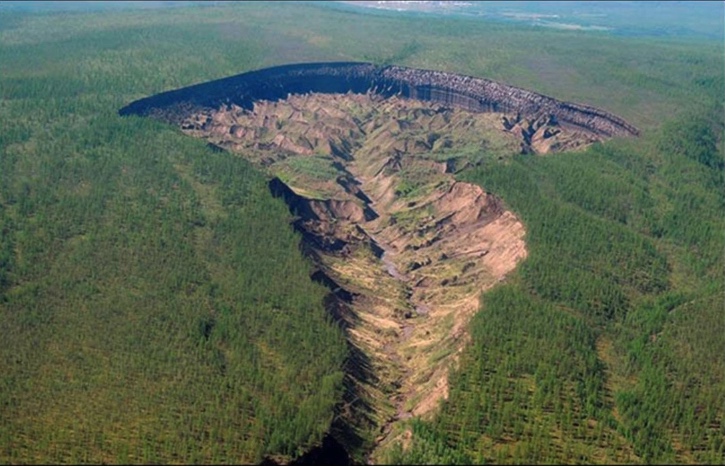
200,000-Year-Old Soil Found In Mysterious Crater: ‘Gateway To The Underworld’
Locals have heard “underworld rumbles” in a giant ravine, but now scientists say it holds secrets from the planet’s past.
It is said that many inhabitants of Yakutia are afraid to approach the Batagaika crater, also known as Batagaika Megaslump: believing in the upper, middle and lower worlds, they see it as a door to the last of them.
The scary noises are probably just the thuds of earth falling into a landmark that is a kilometer-long crack up to 100 meters (328 feet) deep in the Siberian taiga.
Batagaika began to form in the 1960s, after a patch of forest was cut down: the land sank, and has continued to do so, evidently accelerated by recent warmer temperatures that melted the permafrost, thus loosening the layers on the surface And below. The major floods of 2008 increased the size of the depression, which grows by up to 15 meters per year.

These “thermokarst depressions” can be observed in northern Canada, but Batagaika is two or three times deeper. Photos: Alexander Gabyshev, Northern Research Institute of Applied Ecology
The result is an unparalleled natural laboratory for scientists seeking to understand the threat to permafrost due to climate change.
A recent expedition into this partially man-made phenomenon sought to date layers of soil that had been frozen in time as permafrost, and also collect plant and soil samples.
Until now it was believed that the soil layers were around 120,000 years old. But Professor Julian Murton of the University of Sussex – who surveyed the site near the village of Batagai, in the Verkhoyansk district, about 676 kilometers (420 miles) north of Yakutsk, capital of the Sakha Republic – determined that The correct age is around 200,000 years. old.

“This project will allow us to compare data from similar objects in Greenland, China and Antarctica. Data on ancient soils and vegetation will help us reconstruct the history of the Earth,” he told Russian journalists.
Professor Julian Murton: “Batagaika itself caught my attention: its size is astonishing, the crack itself is perfectly exposed, uncovered, all layers are perfectly visible and can be studied thoroughly.” Images: Northern Applied Ecology Research Institute
“I was surprised and excited to learn that we can date the samples found in the lower horizon to 200,000 years ago.” She explained: “We found several layers of buried soil. Two of them look especially promising. They show that thousands of years ago the climate in the Verkhoyansk region was the same as now, and even warmer.
“We took samples of tree remains to discover what type of forests grew in this area. We also took sediment samples that will help us discover what type of soil predominated here in ancient times. Thanks to permafrost, the conservation of organic matter is excellent.
“Batagaika itself caught my attention: its size is amazing, the crack itself is perfectly exposed, uncovered, all layers are perfectly visible and can be studied thoroughly.”

The expedition was a “pilot study” in one of the “most important” sites in the world for the study of permafrost. The samples will be examined in more detail at the Institute of Physicochemical and Biological Problems of Soil Science in Pushchino, near Moscow, she said.
The world’s “most important” sites for the study of permafrost are located near the village of Batagai, in the Verkhoyansk district, about 676 kilometers (420 miles) north of Yakutsk, capital of the Sakha Republic. Images: NEFU, The Siberian Times

The next stage of the work will be to “study ancient ice samples.” He noted that these “thermokarst depressions” can be observed in northern Canada, but Batagaika is two to three times deeper.
Director of the Northern Research Institute of Applied Ecology Grigory Savvinov said: “In the 60s there was a road between the village of Batagai and some industrial facilities. The forest was cut down, which caused the ravine to form. In recent years, amid climate changes due to warming, the ravine grew to the size of a crater.

In 2009, the corpse of a Holocene foal (about 4,400 years old) and the mummified corpse of a bison calf were discovered. Remains of ancient bison, horses, elk, mammoths and reindeer were also found here.
The area is one of the coldest places on the planet and competes with Oymyakon, from the same region, for the title of coldest inhabited place in the world.
Featured image: Batagaika began to form in the 1960s, after a patch of forest was cut down: the land subsided, and continues to do so, evidently accelerated by recent warmer temperatures melting permafrost. Photo: Alexander Gabyshev